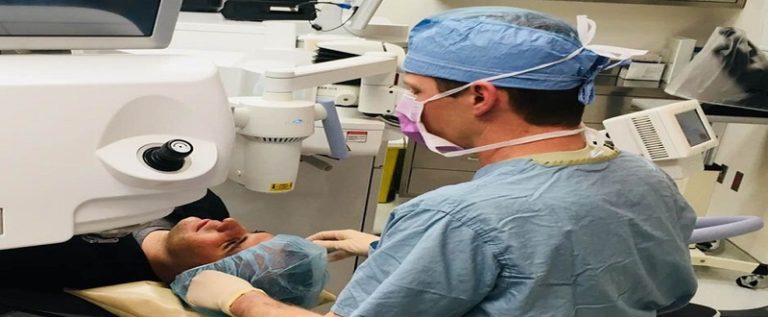Laser Cataract Surgery – Latest Medical Technology

Modern day cataract surgery has evolved a lot in the last 3 decades making it one of the most successful procedures done in eyes. The ophthalmologist have become more surgically competent and confident in giving good results. Different surgical procedure have been adopted to perform cataract surgery with varied success rates. The current gold standard for performing cataract surgery is Femto assisted laser cataract surgery.
Types of Cataract Surgeries
ICCE (Intracapsular Cataract Extraction)
This was the first procedure done to remove the cataract. A large incision (approx 6 mm) was made and the entire cataractous lens along with the lens bag was removed through this incision. After the surgery, 3-5 sutures were placed to secure the wound. IOL was not placed and the patient had to wear spectacles to see clearly.
ECCE (Extracapsular Cataract Extraction) and SICS (Small Incision Cataract Surgery)
In ECCE and SICS, only the cataractous lens was removed. The lens bag was left behind and an IOL was placed in it. A rigid IOL was placed in the lens bag. The IOL helps in focussing of light to the retina and therefore aids in attaining clear vision.
Phacoemulsification
After immense research and improvement in technology, it has become possible to perform cataract surgery through a small incision (2-3mm).
Currently, Phacoemulsification or phaco is the method of choice. It uses a specialised ultrasound to liquefy the lens, which is then aspirated through the small incision. After this, a foldable IOL is placed through the small incision. Since the incision is so small, sutures are not required.
In conventional phacoemulsification, a specialised blade is used to make the incisions.
Laser Cataract Surgery
During cataract surgery, corneal incisions can be made with either blade or by laser machine. Laser cataract surgery is the latest advancement in cataract surgery where blades are not used at all. The incisions are made using a specialised laser called femto laser. The femto laser also makes an opening in the lens bag and breaks the cataract into very small pieces. This reduces the amount of phaco energy used, thereby preserving the structures of the eye. After this, a foldable IOL is placed in the lens bag.
Main steps done by laser system include:
The Corneal Incision
In laser cataract surgery, blade is not used. All the opening incisions in the cornea are made by the laser itself. These incisions can be placed at the specific positions pre-decided by the operating surgeon. The size and angulation of these incisions are extremely accurate which makes them completely self-sealing. This is the reason why laser cataract surgery is also called bladeless cataract surgery.
The Anterior Capsulotomy
Lens is enclosed in a thin capsular bag inside the eye and for removing the cataract. The front or anterior layer of this bag has to be opened up in order to remove the cataract and to be able to place an intraocular lens. This step is called anterior capsulotomy. In this, a circular hole of approximately 5 mm is made in the centre of the front layer of the lens bag. This is a very important and crucial step in cataract surgery. Laser performs this step accurately and in the desired way.
Lens or Cataract Fragmentation
Lens of the patient’s eye is broken down into very small pieces by the femto laser. Once this step is done, those lens fragments are emulsified or liquefied using the phacoemulsification. In this way, lot of energy and time is saved during cataract surgery. Because of lesser phaco energy used in the surgery, less postoperative inflammation occurs and patient gains good vision very early.
Laser assisted cataract surgery in complicated cases:
The importance of Laser assisted cataract surgery in complicated cases cannot be overemphasized.
Very Hard Cataracts
Hypermature or brown cataracts are very hard and sometimes leathery. They require a lot of phaco energy to be liquified. The prolonged exposure of the corneal endothelium to this phaco energy can lead to death of its delicate cells. Corneal endothelium is the innermost layer of the cornea and has a major role in maintaining the corneal clarity. Once lost, the corneal endothelial cells can’t regenerate resulting in swelling of the cornea or corneal edema.
Intumescent Cataracts
In Intumescent cataracts, the cataractous lens is swollen up leading to stretching of the anterior capsule. Attaining a round central and circular anterior capsulotomy is a challenge in such cases. Laser comes to our aid in such cases where it accurately makes a round and central anterior capsulotomy. Once this step is achieved, removal of the lens and placement of the IOL becomes much easier.
Traumatic Cataracts
After injuries, the lens bag can become weak and the fine fibers suspending it in its position can be broken or lost. In these cases, femto laser helps in making the anterior capsulotomy and in making the lens fragments thereby improving the outcomes of cataract surgery.




Leave a Reply